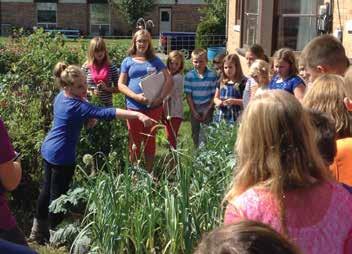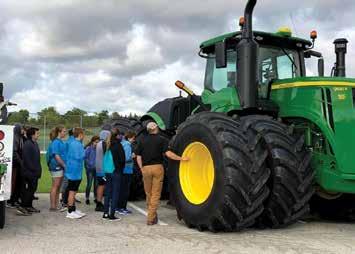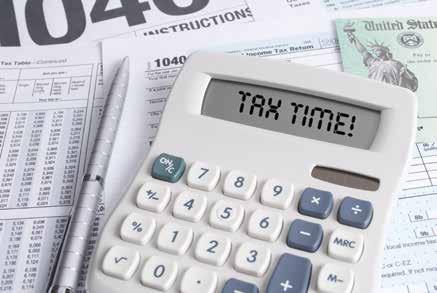
9 minute read
NATIONAL AG DAY
Plan Now to Participate in National Ag Day
National Ag Day will be celebrated on March 24 and is a time for farmers and consumers alike to celebrate agriculture, farmers and the food on our dinner tables.
Advertisement
This year’s theme is, "Food brings everyone to the table." Wisconsin Farm Bureau and Wisconsin Ag in the Classroom have many ways for people of all ages to join the celebration. If you are posting on social media about National Ag Day or your role in bringing food to the dinner table, be sure to use #WIAgProud. Cooking Demonstration
Wisconsin Farm Bureau will be partnering with other commodity groups in Wisconsin to share a live cooking demonstration on National Ag Day. This cooking demo will serve as a time to talk about Wisconsin-grown foods, nutrition information and of course learn some new, tasty recipes.
Follow Wisconsin Farm Bureau Federation on Facebook or mark ‘interested’ or ‘going’ on the National Ag Day Facebook event for more information. Ag in the Classroom Reading Event
Celebrate Ag Day by joining farmers, teachers, FFA and 4-H members, college students and other agricultural enthusiasts by reading books about agriculture. Participants are encouraged to identify a group they want to read to. Group ideas include elementary classrooms, home school families, nursing home residents, daycare groups or anywhere people are interested in learning about agriculture. The recommended book is the Wisconsin Ag in the Classroom’s Book of the Year, "Right This Very Minute" by Wisconsin author Lisl Detlefsen. The book is available for purchase at
wiagclassroom.com in the online store. There are activities, background information and talking points available.
Readers are welcome to choose other accurate books about agriculture too. After the visit, participants are asked to complete a report form, available on the Wisconsin Ag in the Classroom website, so the outreach of the activities can be tabulated. Please use #WiReadsAg2020 on social media to talk about National Ag Day and your reading activity.

Youth Contest Wisconsin Ag in the Classroom is hosting a youth contest where students are asked to draw and color a picture that shows people who are involved in growing, producing, processing, selling, preparing or have another connection to how food gets to the table. They may focus on one person or several and may add a caption to describe their picture. Entries are due March 31.
The contest is open to children ages 12 and younger with three divisions: ages 6 and younger, ages 7-9 and ages 10-12. The entry page and contest rules are located on the Wisconsin Ag in the Classroom website at wisagclassroom.org under the Events and National Ag Day tab. All the contest rules and forms are in the 2020 Ag Day activities and contest booklet. Art drawn by 2018 contest winner June Rihn in the ages 10-12 category.

RACES INTO 2020
The Ag in the Classroom program is ‘zoom’ing into the new decade literally and figuratively. Zoom is a webinar platform that Ag in the Classroom is now using to host virtual trainings for volunteers and teachers. The program’s YouTube channel is home to the recorded trainings. If you can’t attend meetings and trainings
Essay Contest This year’s fourth- and fifth-grade essay contest topic is “How has Wisconsin agriculture affected your life today?” Students can write about how agriculture affects us daily with food, shelter, jobs, businesses and other aspects. Essays need to be postmarked by April 1 and should be returned to county essay coordinators. Lessons, rules and other resources are on the website.
Matching Grants Matching grants of up to $500 to groups sponsoring programs or projects that promote agricultural literacy. Grants will be awarded in amounts up to $500 to applicants that secure or provide equal matching funds for the proposed project. Applications are due March 1.
Wisconsin Farm Facts
The 2020 Wisconsin Farm Facts brochure will be available this spring. This year it has an emphasis on soils, turf and the green industry. Culver’s is sponsoring the printing of the brochures and the updated book marks. We appreciate their support of the Wisconsin Ag in the Classroom program.
County and state Farm Bureaus may apply for $1,000 educational grants for grades K-12 in order to initiate new ag literacy programs or expand existing programs. Grants are available on a competitive basis. Two grant cycles are offered each year. The next submission deadline is April 15.
in real-time, this is a great way to keep up to date on what’s happening and new resources. Watch for other playlists of videos that relate to education and agriculture.
Ag in the Classroom has many other events and activities happening throughout the year. Find more information on wisagclassroom.org.
Workshop at IGNITE
‘Connecting with Ag in the Classroom’ will be offered during the IGNITE Conference, March 28 and 29. This workshop will explore the basics of the Ag in the Classroom program and how you can recruit volunteers, reach teachers and students, use resources for special events outside of a traditional classroom and share information on how your county is organized. Websites, resources and how to host or promote teacher and volunteer training sessions also will be covered.
American Farm Bureau Foundation for Agriculture Food and Farm Facts The new edition of this brochure came out in fall 2019 and all the supplementary resources are available. This book features facts about food in America, how it’s grown and who produces it using color photographs, charts and infographics. Online resources are available. Wisconsin Ag in the Classroom carries the books, trivia cards, pocket guides, pencils and fourththrough sixth-grade activity guides in the online store.
National Ag in the Classroom Conference This year the conference is June 23-26 in Salt Lake City, Utah. Teachers, volunteers and staff will enjoy visiting Utah agricultural businesses; onsite workshops that demonstrate how to use agricultural resources to contextualize standards in reading, writing, math, science, social studies and nutrition; and dynamic keynote speakers who support Agriculture in the Classroom’s mission of promoting the importance of agriculture.
Matching Grants Available Through Ag in the Classroom T he Wisconsin Ag in the Classroom Program is accepting applications for matching grants, up to $500, that will be awarded to groups conducting activities that promote agricultural literacy in K-12 schools.
Projects that use funds toward an ongoing, sustainable education effort will receive preference over a one-time program. Applicants must have a matching donor for their project equal to the amount of the Ag in the Classroom grant. The application deadline is March 1. Interested groups or schools can get an application on the Wisconsin Ag in the Classroom website at wisagclassroom.org, by clicking on the ‘Grants & Awards’ section. You may also contact Darlene Arneson, Wisconsin Ag in the Classroom Coordinator, at darneson@wfbf.com or 608.828.5644.
ST. MARY SCHOOL - 2019 AWARDED $500 FOR GARDEN PROJECT

Thank You
to the Following WFB Foundation Donors: (Donations were made between December 3, 2019, and January 29, 2020 • Christina Jones in memory of Lucille Casey • Dan and Jean Poulson in memory of Barbara Brock • Donna Stewart in memory of Lucille Casey • RJJG LLC in memory of Lucille Casey • Green Lake County Farm Bureau in memory of Duke Lohrey
About the Foundation
The Wisconsin Farm Bureau Foundation was established in 1988 to provide support for agricultural education and leadership programs. Through donations and other contributions, the foundation invests time and resources to support the next generation of agriculturists.
KIEL FFA ALUMNI - 2019 AWARDED $500 FOR AG CAREER AWARENESS DAY


Don't Let Identity Thieves Enjoy Your Tax Refund A re you anticipating a tax refund this year? Maybe you have plans for a new TV or a vacation. But imagine if someone beats you to your refund by filing a fraudulent tax return, putting your plans on hold. Instead, you will have an identity theft mess to clean up.


Tax scams and identity fraud by the numbers The good news: In the U.S., tax return fraud declined 70 percent between 2015 and 2018, as the Internal Revenue Service developed new systems for spotting identity theft in tax returns. The bad news: Tax-related identity theft and fraud increased 10 percent last year for U.S. businesses and remained a key source of frustration for individual taxpayers, too. In 2019, the IRS identified 3,741 fraudulent tax returns with identity theft and prevented the issuance of $16.7 million in fraudulent tax refunds. How tax return fraud happens
Tax-related identity theft can leave taxpayers bewildered and frustrated, but the mechanics of it are fairly simple. First, identity thieves obtain sensitive information about you including your name, address or personal tax identification number. They can either buy the information from criminal sources or trick you into giving it to them through phishing or phone scams. Then they use it to file a tax return using a false address or post office box and wait for the refund check to roll in. Warning signs of tax return fraud
There are several warning signs that indicate you may be a victim of tax return fraud: • The IRS or other taxing authority rejects your attempt to file your tax return. • The taxing authority requests verification of your identity, indicating something may be amiss. • Income is reported by two or more employers, most likely because someone else has used your tax identification number to gain employment. Your return could be flagged for failing to pay sufficient taxes on wages or to report wages. File early to protect yourself
Preempt identity thieves trying to cash in on your good name by filing your tax return as early as possible. When they try to file after you, it will be their fraudulent return that is rejected instead of yours. This is the single best way to reduce your chance of becoming a victim of tax identity fraud. Resolve tax-related identity theft
If you discover you have become a victim, follow these steps: 1. Contact your taxing authority and fill out identity theft paperwork. 2. File your correct return using the instructions they provide you. 3. Contact the credit bureaus and place a fraud alert on your account. 4. Respond promptly to all correspondence from your taxing authority. 5. Keep excellent records of all of your correspondence and filings. 6. Add a credit monitoring and identity protection service to identify any further identity theft or fraud in other areas of your life.










